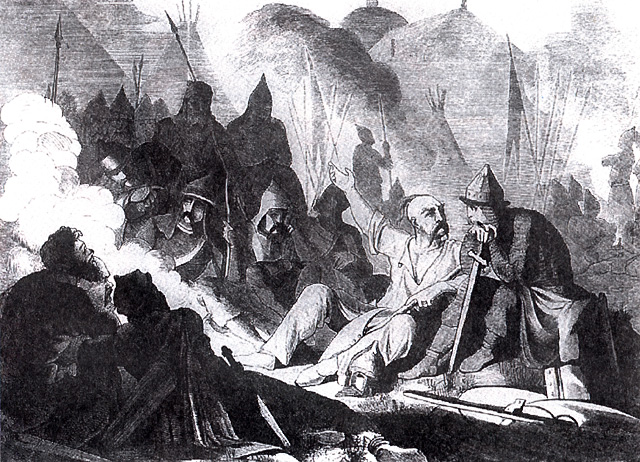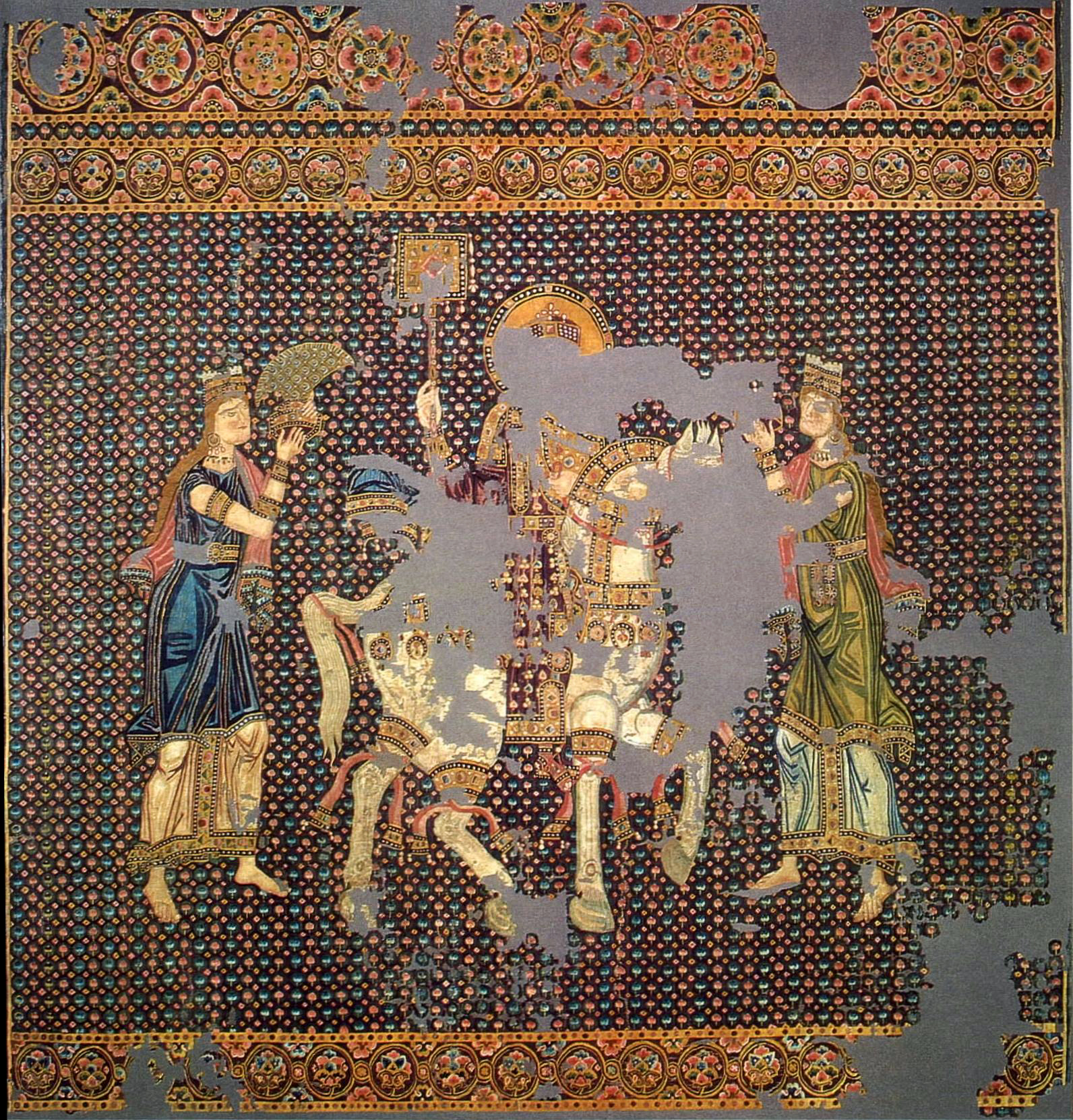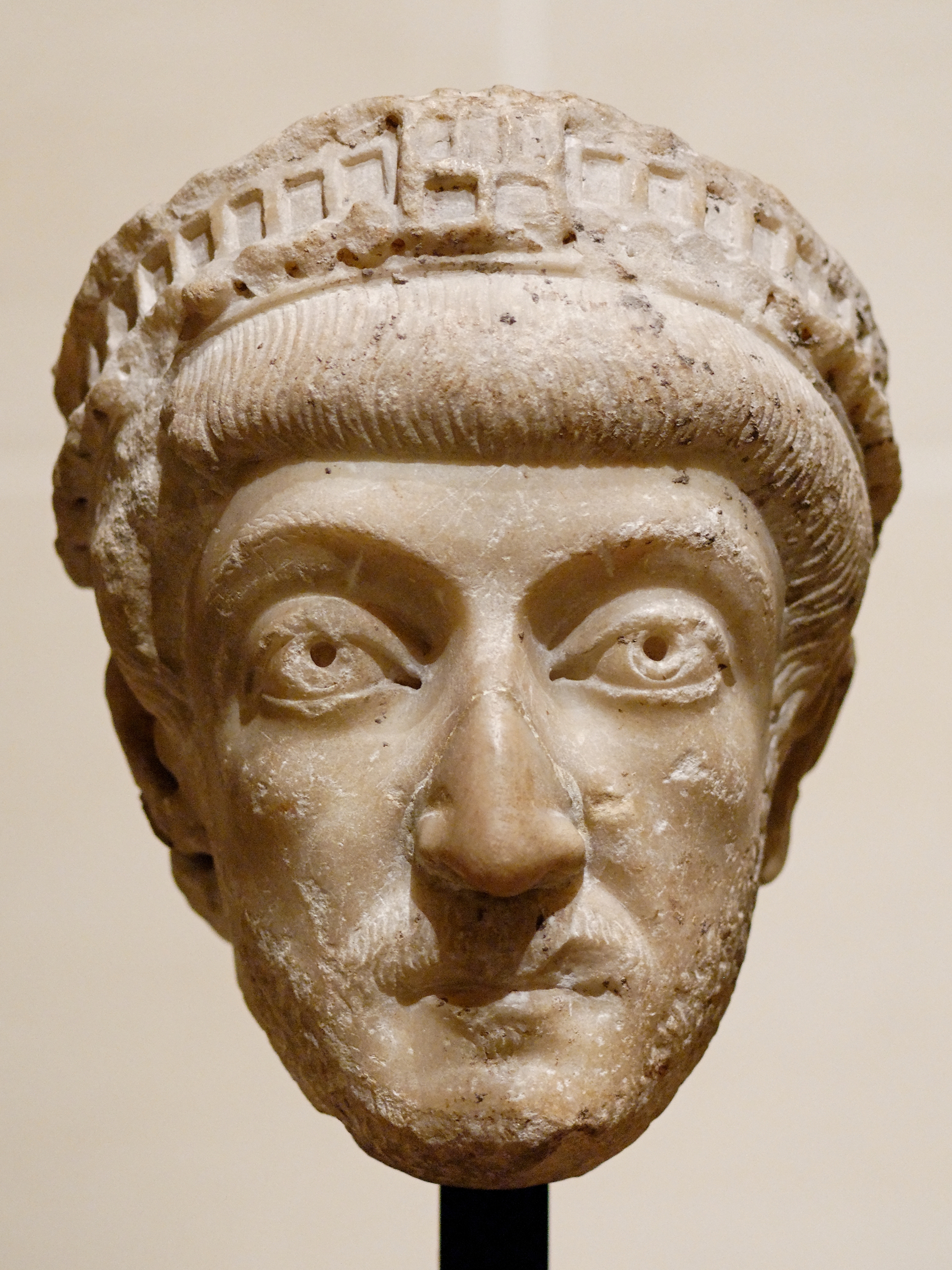|
Tzimiskes
John I Tzimiskes (; 925 – 10 January 976) was the senior Byzantine emperor from 969 to 976. An intuitive and successful general who married into the influential Skleros family, he strengthened and expanded the Byzantine Empire to include Thrace and Syria by warring with the Rus' under Sviatoslav I and the Fatimids respectively. Background John was born in present-day Çemişgezek in Tunceli Province. His father, son of Theophilos Kourkouas, was a scion of the Kourkouas family, a clan of Armenian origin that had established itself as one of the chief families among the Anatolian military aristocracy by the early 10th century. His mother belonging to the Phokas family of unknown ethnicity, maybe Greek-Armenian origin. Scholars have speculated that "''Tzimiskes''" was derived either from the Armenian ''Chmushkik'' (Չմշկիկ), meaning "red boot", or from an Armenian word for "short stature", as explained by Leo the Deacon. A more favorable explanation is offered ... [...More Info...] [...Related Items...] OR: [Wikipedia] [Google] [Baidu] |
Nikephoros II Phokas
Nikephoros II Phokas (; – 11 December 969), Latinized Nicephorus II Phocas, was Byzantine emperor from 963 to 969. His career, not uniformly successful in matters of statecraft or of war, nonetheless greatly contributed to the resurgence of the Byzantine Empire during the 10th century. In the east, Nikephoros completed the conquest of Cilicia and retook the islands of Crete and Cyprus, opening the path for subsequent Byzantine incursions reaching as far as Upper Mesopotamia and the Levant; these campaigns earned him the sobriquet "pale death of the Saracens". Early life and career Nikephoros Phokas was born around 912. From his paternal side, he belonged to the Phokas family which had produced several distinguished generals, including Nikephoros' father Bardas Phokas, brother Leo Phokas, and grandfather Nikephoros Phokas the Elder, who had all served as commanders of the field army ('' domestikos tōn scholōn''). From his maternal side he belonged to the Maleinoi, a pow ... [...More Info...] [...Related Items...] OR: [Wikipedia] [Google] [Baidu] |
Sviatoslav I
Sviatoslav or Svyatoslav I Igorevich (; Old Norse: ''Sveinald''; – 972) was Prince of Kiev from 945 until his death in 972. He is known for his persistent campaigns in the east and south, which precipitated the collapse of two great powers in Eastern Europe, Khazars, Khazaria and the First Bulgarian Empire. He conquered numerous East Slavs, East Slavic tribes, defeated the Alans and attacked the Volga Bulgaria, Volga Bulgars, and at times was allied with the Pechenegs and Hungarian people, Magyars (Hungarians). Following the death of his father Igor of Kiev, Igor in 945, Sviatoslav's mother Olga of Kiev, Olga reigned as regent in Kiev until 962. His decade-long reign over the Kievan Rus' was marked by rapid expansion into the Volga, Volga River valley, the Pontic–Caspian steppe, Pontic steppe, and the Balkans, leading him to carve out for himself the largest state in Europe. In 969, he moved his seat to Pereyaslavets on the Danube. In 970, he appointed his sons Yaropolk I ... [...More Info...] [...Related Items...] OR: [Wikipedia] [Google] [Baidu] |
Gunthertuch
The () is a Byzantine silk tapestry which represents the Roman triumph, triumphal return of a Byzantine Emperor from a victorious campaign. The piece was purchased, or possibly received as a gift, by Gunther von Bamberg, Bishop of Bamberg, during his 1064–65 pilgrimage to the Holy Land. Gunther died on his return journey, and was buried with it in the Bamberg Cathedral. The fabric was rediscovered in 1830, and is now exhibited in the Bamberg Diocesan Museum. History In November 1064, Gunther took part in the so-called "Great German Pilgrimage of 1064–1065, Great German Pilgrimage" to Jerusalem, under the leadership of the archbishop of Mainz, Siegfried I (Archbishop of Mainz), Siegfried I; the Archdiocese of Utrecht (695–1580), bishop of Utrecht, William I (Bishop of Utrecht), William I; and the bishop of Regensburg, Otto von Riedenburg. The pilgrims, numbering some 7,000 people, journeyed through Kingdom of Hungary, Hungary and then through the Byzantine Empire to the Holy ... [...More Info...] [...Related Items...] OR: [Wikipedia] [Google] [Baidu] |
Basil II
Basil II Porphyrogenitus (; 958 – 15 December 1025), nicknamed the Bulgar Slayer (, ), was the senior Byzantine emperor from 976 to 1025. He and his brother Constantine VIII were crowned before their father Romanos II died in 963, but they were too young to rule. The throne thus went to two generals, Nikephoros Phokas (963–969) and John Tzimiskes (r. 969–976) before Basil became senior emperor, though his influential great-uncle Basil Lekapenos remained as the '' de facto'' ruler until 985. His reign of 49 years and 11 months was the longest of any Roman emperor. The early years of Basil's reign were dominated by civil wars against two powerful generals from the Byzantine Anatolian aristocracy: first Bardas Skleros and later Bardas Phokas, which ended shortly after Phokas' death and Skleros' submission in 989. Basil then oversaw the stabilization and expansion of the eastern frontier of the Byzantine Empire and the complete subjugation of the First Bulgarian Empire ... [...More Info...] [...Related Items...] OR: [Wikipedia] [Google] [Baidu] |
Byzantine Emperor
The foundation of Constantinople in 330 AD marks the conventional start of the Eastern Roman Empire, which Fall of Constantinople, fell to the Ottoman Empire in 1453 AD. Only the emperors who were recognized as legitimate rulers and exercised sovereign authority are included, to the exclusion of junior co-emperors who never attained the status of sole or senior ruler, as well as of the List of Byzantine usurpers, various usurpers or rebels who claimed the imperial title. The following list starts with Constantine the Great, the first Christian emperor, who rebuilt the city of Byzantium as an imperial capital, Constantinople, and who was regarded by the later emperors as the model ruler. Modern historians distinguish this later phase of the Roman Empire as Byzantine due to the imperial seat moving from Rome to Byzantium, the Empire's integration of Christianity, and the predominance of Greek instead of Latin. The Byzantine Empire was the direct legal continuation of the eastern ... [...More Info...] [...Related Items...] OR: [Wikipedia] [Google] [Baidu] |
Theophilos Kourkouas
Theophilos Kourkouas (, fl. ca. 920–960s) was a distinguished Byzantine general in the 10th century. He was also the grandfather of the Byzantine emperor John I Tzimiskes (r. 969–976). Biography Theophilos was a scion of the Kourkouas family, a clan of Armenian origin that had established itself as one of the chief families among the Anatolian military aristocracy by the early 10th century. His father was likely called Romanos, and he was possibly the grandson of John Kourkouas the Elder, who served as commander of the Hikanatoi regiment and conspired against Emperor Basil I (r. 867–886) in the 870s. Theophilos is probably to be identified with the person referred to in contemporary Arabic and Armenian sources as ''ash-Shamīshāq'' or ''Ch‘mšshik'' respectively, indicating that he already bore the surname or sobriquet of Tzimiskes, which was famously borne by his grandson, the Emperor John I Tzimiskes (r. 969–976). Although the Byzantine sources insist that ... [...More Info...] [...Related Items...] OR: [Wikipedia] [Google] [Baidu] |
List Of Byzantine Emperors
The foundation of Constantinople in 330 AD marks the conventional start of the Eastern Roman Empire, which Fall of Constantinople, fell to the Ottoman Empire in 1453 AD. Only the emperors who were recognized as legitimate rulers and exercised sovereign authority are included, to the exclusion of junior co-emperors who never attained the status of sole or senior ruler, as well as of the List of Byzantine usurpers, various usurpers or rebels who claimed the imperial title. The following list starts with Constantine the Great, the first Christian emperor, who rebuilt the city of Byzantium as an imperial capital, Constantinople, and who was regarded by the later emperors as the model ruler. Modern historians distinguish this later phase of the Roman Empire as Byzantine due to the imperial seat moving from Rome to Byzantium, the Empire's integration of Christianity, and the predominance of Greek instead of Latin. The Byzantine Empire was the direct legal continuation of the eastern ... [...More Info...] [...Related Items...] OR: [Wikipedia] [Google] [Baidu] |
Skleros
The Skleros (; plural: Σκληροί, ''Skleroi''), latinized Sclerus, feminine form Skleraina (Σκλήραινα), Latinized Scleraena, was a noble Byzantine family active mostly in the 9th–11th centuries as members of the military aristocracy, and as civil functionaries thereafter. Origin and early members The family descended from north-eastern Asia Minor, either from Lesser Armenia or the theme of Sebasteia. Due to their place of origin, they have been traditionally regarded as Armenians, although this is nowhere explicitly attested. It has also been suggested that the family was mixed Greek–Armenian. However, the evidence for the family's alleged Armenian origins is tenuous. The Greek surname Skleros () indicates that the family's founding father may have been at least partly Greek, since Byzantines of Armenian origin generally had surnames that were recognizably Armenian with simply a Greek suffix. The Skleros have been linked more specifically with the area arou ... [...More Info...] [...Related Items...] OR: [Wikipedia] [Google] [Baidu] |
Phokas (Byzantine Family)
Phokas () or Phocas ( Latinized), feminine form Phokaina or Phocaena (, ), was the name of a Byzantine aristocratic clan from Cappadocia, which in the 9th and 10th centuries provided a series of high-ranking generals and an emperor, Nikephoros II Phokas (963–969). Its members and their clients monopolized the high-command positions of the Byzantine army for much of the 10th century and led the successful Byzantine offensive against the Arabs in the East. As one of the leading families of the Anatolian military aristocracy, the Phokades were also involved in a series of rebellions that laid claim to power and challenged the emperors at Constantinople. Their power was eventually broken by Basil II (r. 976–1025), and the family declined in importance after the 11th century. History Origin and early members The Byzantine official and historian Michael Attaleiates, writing in the second half of the 11th century, claimed to have come across the genealogical tree of the family in an ... [...More Info...] [...Related Items...] OR: [Wikipedia] [Google] [Baidu] |
Theodora (daughter Of Constantine VII)
Theodora (Greek: Θεοδώρα; – after 971) was Byzantine empress as the second wife of John I Tzimiskes.Lynda Garland (2006). ''Byzantine Women: Varieties of Experience 800-1200''. She was a daughter of Constantine VII and Helena Lekapene. Her maternal grandparents were Romanos I Lekapenos and Theodora. The work ''Theophanes Continuatus'' was a continuation of the chronicle of Theophanes the Confessor by other writers, active during the reign of her father. The chronicle ends in 961 and records her fate following the death of Constantine VII on 9 November 959. Her brother Romanos II succeeded to the throne and his wife Theophano convinced him to send all five of his sisters to the convent of Kanikleion. Theodora and her sisters Zoe, Agatha, Theophano and Anna were initially held in Kanikleion. Later they were split: Theodora, Zoe, and Theophano were sent to the monastery of Antiochus, while Agatha and Anna were sent to Myrelaion, a nunnery built by their maternal grandfat ... [...More Info...] [...Related Items...] OR: [Wikipedia] [Google] [Baidu] |
Coronation Of The Byzantine Emperor
The coronation (, or , ) was the main symbolic act of accession to the throne of a Byzantine emperor, co-emperor, or empress. Founded on Roman traditions of election by the Senate or acclamation by the army, the ceremony evolved over time from a relatively simple, ''ad hoc'' affair to a complex ritual. In the 5th–6th centuries the coronation became gradually standardized, with the new emperor appearing before the people and army at the Hippodrome of Constantinople, where he was crowned and acclaimed. During the same time, religious elements, notably the presence of the Patriarch of Constantinople, became prominent in what was previously a purely military or civilian ceremony. From the early 7th century on, the coronation ceremony usually took place in a church, chiefly the Hagia Sophia, the patriarchal cathedral of Constantinople. The association of the coronation ceremony with Constantinople and the Hagia Sophia became so close that even emperors who had been proclaimed, and c ... [...More Info...] [...Related Items...] OR: [Wikipedia] [Google] [Baidu] |
Macedonian Dynasty
The Macedonian dynasty () Byzantine Empire under the Macedonian dynasty, ruled the Byzantine Empire from 867 to 1056, following the Byzantium under the Amorian dynasty, Amorian dynasty. During this period, the Byzantine state reached its greatest extent since the Early Muslim conquests, and the Macedonian Renaissance in letters and arts began. The dynasty was named after its founder, Basil I the Macedonian who came from the theme (Byzantine district), theme of Macedonia (theme), Macedonia. Origins The dynasty's ethnic origin is unknown, and has been a subject of debate. During Basil's reign, an elaborate genealogy was produced that purported that his ancestors were not mere peasants, as everyone believed, but descendants of the Arsacid dynasty of Armenia, Arsacid (Arshakuni) kings of Armenia, Alexander the Great and also of Constantine the Great. Some Persian writers such as Hamza al-Isfahani or Al-Tabari, called Basil a ''Saqlabi'', an ethnogeographic term that usually denoted ... [...More Info...] [...Related Items...] OR: [Wikipedia] [Google] [Baidu] |









